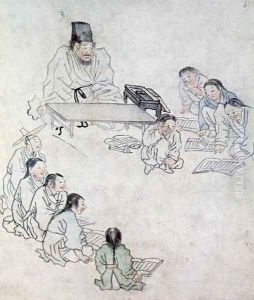Kim Hong-Do Paintings
Kim Hong-Do, also known by his pen name Danwon, was a prominent Korean painter born in 1745 during the Joseon Dynasty. His exact date of death is uncertain, with some records suggesting it may have been around 1806. Kim Hong-Do is renowned for his genre paintings depicting the daily life of commoners, a subject that was somewhat unusual for an era that typically focused on landscapes and portraits of the nobility.
Kim was born in Ansan in Gyeonggi Province and displayed artistic talent from an early age. He was recognized by a local scholar who recommended him to the royal court. His skills earned him a position as a court painter, and he received training from the master court painter Pyoam Kang Se-hwang. Throughout his career, Kim Hong-Do served under King Jeongjo, who was an avid patron of the arts and a reformer who encouraged cultural flourishing.
In his paintings, Kim Hong-Do captured a wide array of subjects, from laborers in the fields and merchants in the marketplace to scholars in their studies and aristocrats in leisurely pursuits. He had a keen eye for detail and a talent for capturing the subtleties of human expression and movement. His work is characterized by its dynamic composition, realistic style, and often, a subtle sense of humor.
Kim Hong-Do's genre paintings are considered some of the most important works of Korean art history and provide invaluable insights into the culture and lifestyle of the Joseon period. He was also skilled in other painting styles, including landscapes, portraits, and Buddhist paintings. His versatility and ability to portray a wide spectrum of society through his art contributed to his legacy as one of Korea's most celebrated artists.
Despite his significant contributions to Korean art, much of Kim Hong-Do's life remains shrouded in mystery, and many of his works have been lost over time. Nevertheless, those that survive continue to be celebrated for their historical value and artistic excellence. Kim Hong-Do's influence persists in Korean art, and he remains a revered figure for his pioneering role in genre painting and his mastery of various painting styles.
